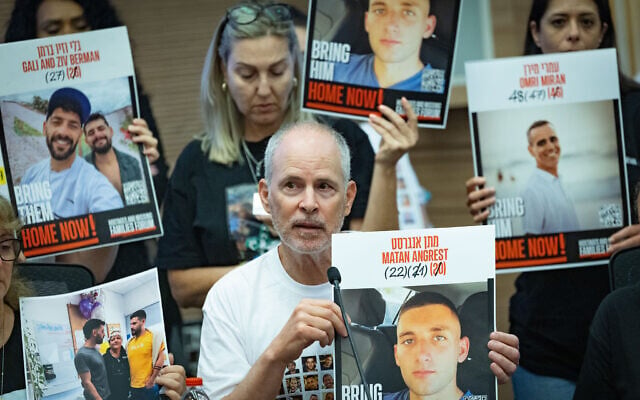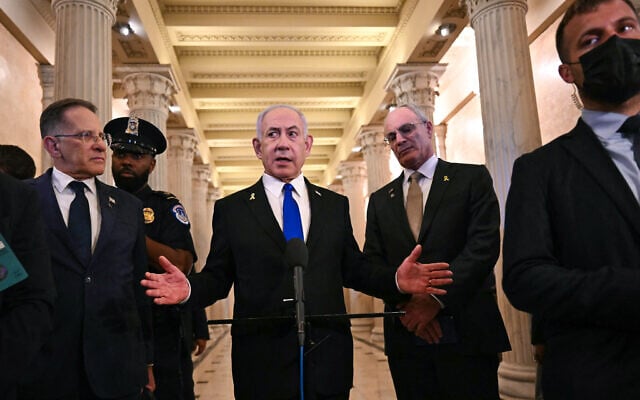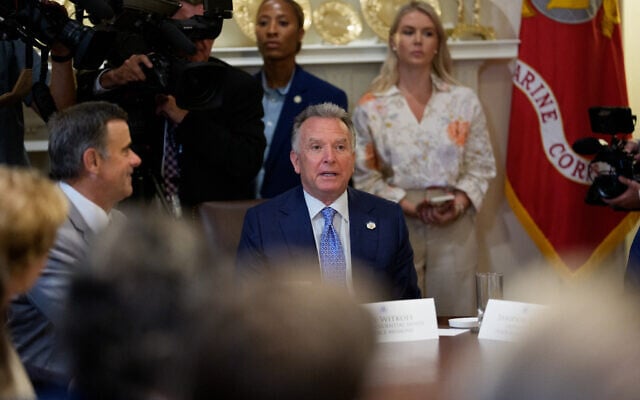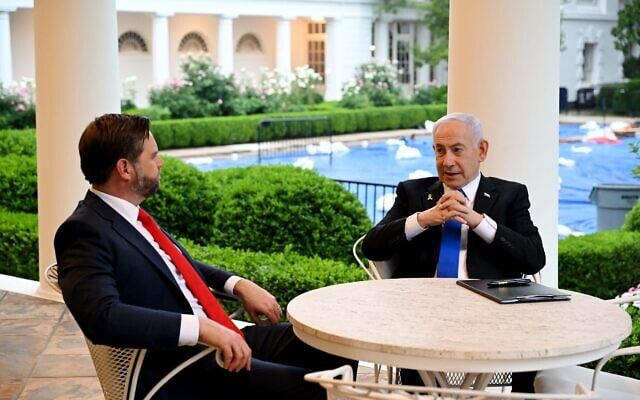


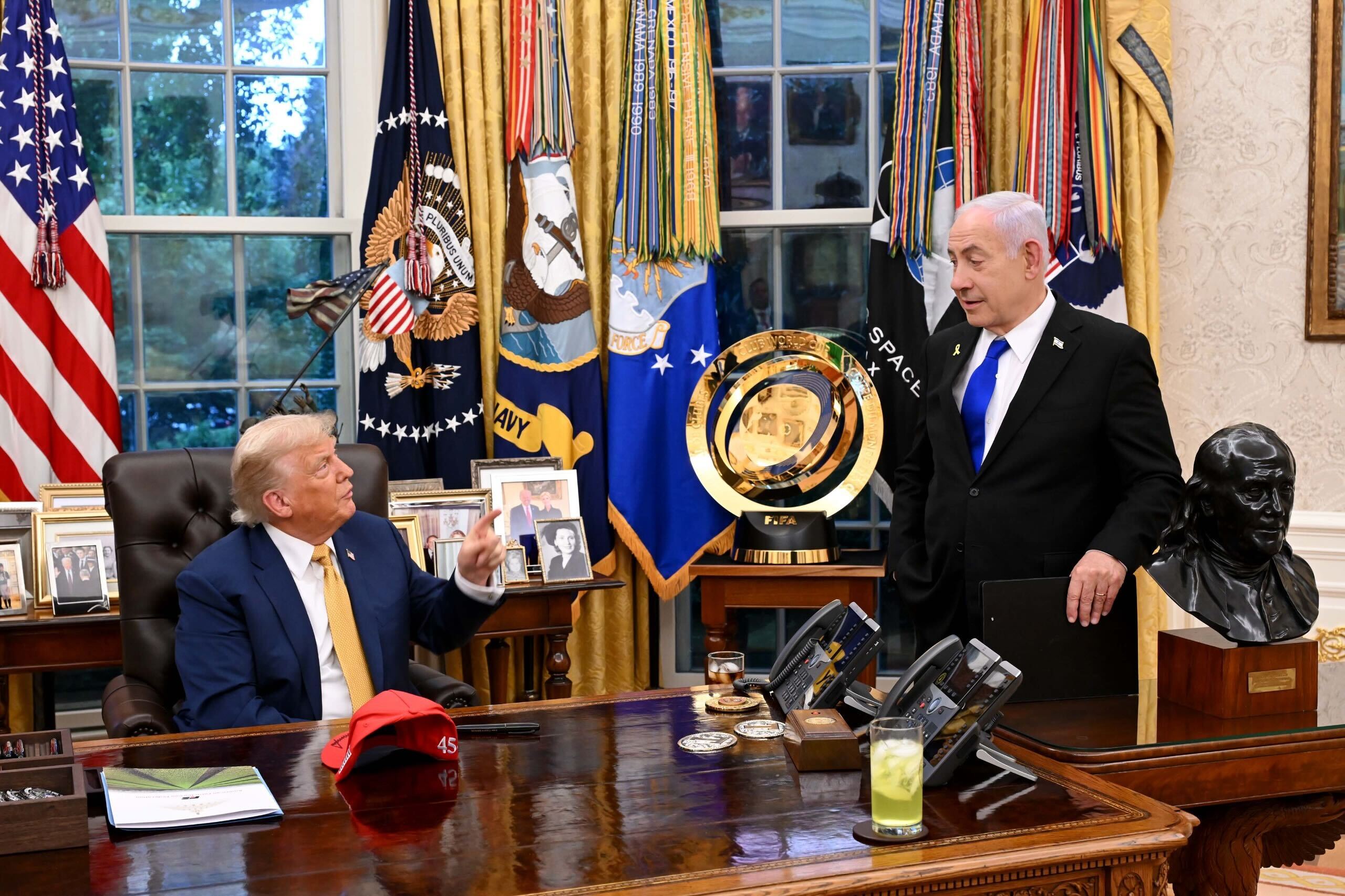
WASHINGTON — Prime Minister Benjamin Netanyahu wrapped up his second White House meeting with US President Donald Trump in as many days without any public announcement of a breakthrough in the ongoing Gaza ceasefire and hostage release talks, which was the primary topic of the sit-down.
The possibility of such a declaration appeared to rise after the meeting was publicly added to Netanyahu’s schedule just hours in advance, with Trump saying they would discuss the Gaza Strip while US special envoy Mideast Steve Witkoff expressed hope a deal could be reached this week.
But as Netanyahu and Trump met for over an hour in the Oval Office along with US Vice President JD Vance, two sources familiar with the matter told The Times of Israel that Witkoff decided to push back his flight to Doha, where he had been slated to join ongoing proximity talks between Israel and Hamas.
Witkoff initially was slated to fly to Qatar on Tuesday, the sources said, adding that a new departure date had yet to be scheduled.
The US envoy informed mediators that he still plans to travel to Doha in order to help bring the deal across the finish line, with his decision to push back the trip indicating that a significant amount of progress still needed to be made.
The Saudi Asharq News outlet cited unnamed “informed sources” who reported that the fifth round of proximity talks in Qatar ended Tuesday night without significant progress.
A Palestinian official told the news site that talks were “at a standstill,” charging that the Israeli negotiations team is “limiting itself to listening rather than negotiating” and consulting on “every issue” with Netanyahu and Strategic Affairs Minister Ron Dermer, the lead Israeli negotiator who is accompanying the premier in Washington.
The Palestinian official claimed the Israeli team lacks authority to make actual decisions, “a continuation of the stalling policy of Netanyahu to obstruct any potential agreement.”
Shortly before Netanyahu met with Trump on Tuesday, a delegation of senior Qatari officials held talks with Witkoff for three hours at the White House to discuss the hostage negotiations, a source familiar with the matter said.
Four sources familiar with the negotiations told The Times of Israel that the US is more optimistic than Egyptian and Qatari mediators about the chances that a Gaza ceasefire and hostage release deal can be reached this week.
Witkoff told reporters earlier Tuesday that he is hopeful a deal can be reached this week, and that three of the four sticking points were resolved during the past three days of proximity talks in Doha.
A source familiar with the matter said the three issues Witkoff suggested have been solved were Hamas’s demand for guarantees from the mediators that the ceasefire will remain in place even if talks on the terms of a permanent ceasefire have not wrapped up by the end of the 60-day truce under discussion; Hamas’s demand for aid to be surged into Gaza through UN-backed mechanisms; and terms of the hostage-prisoner swap.
The source noted that while progress was made on the first two issues, the identities of Israelis and Palestinians to be released in the deal have not yet been discussed by the negotiators in Doha, with Hamas insisting that other matters be resolved first.
However, the number and identities of those being released are not considered as thorny an issue as the others, the source said, speculating that this was why Witkoff grouped the hostage-prisoner swap component of the deal with the issues that have already been resolved.
Regarding the issue of aid, negotiators in Doha offered initial backing for clauses in the agreement that would prevent the Gaza Humanitarian Foundation from operating in areas where the IDF has withdrawn from, a source familiar with the negotiations told The Times of Israel.
Only the UN and international organizations that are not connected to either Israel or Hamas will be responsible for distributing aid in areas where the IDF is no longer located, the source said.
The remaining obstacle is the partial withdrawal of the IDF from Gaza during the length of the 60-day truce, a US official and the source familiar with the talks said. Israel is insisting that it remain in the Morag Corridor in southern Gaza near where it plans to create a “humanitarian city” in which Strip’s entire population will be herded and prevented from leaving once vetted.
Defense Minister Israel Katz briefed reporters on the idea earlier this week, sparking international uproar with talk of concentrating a population of 2 million people in such a small area, while barring them from leaving. Katz framed the plan as a mechanism for protecting the population, with humanitarian aid to be distributed in the area. However, international confidence in Israeli humanitarian initiatives is low after Gazans started coming under deadly IDF fire on a near-daily basis while trying to reach aid distribution hubs established by Israel and operated by the nascent Gaza Humanitarian Foundation since May.
Katz’s briefing marred the hostage talks in Doha, Palestinian sources told the Kan public broadcaster, saying that his remarks led Hamas to be less flexibility regarding the withdrawal of Israeli forces.
Due to disagreements over the parameters of the Israel Defense Forces’ withdrawal from Gaza during the 60-day truce being negotiated in Doha, Israel was slated to submit a new set of maps on Wednesday showing its proposed redeployment of troops after the previous version was rejected by Hamas, a source familiar with the negotiations told The Times of Israel.
A compromise on the issue will take more time to secure, the source said, declining to elaborate further.
Two Arab diplomats briefed on the talks told The Times of Israel that Egypt and Qatar were far less optimistic about the chances of reaching a ceasefire this week, arguing that the gaps are more prominent than Witkoff indicated.
While the US offered Hamas a verbal assurance on Tuesday through mediators that Trump will personally make sure the temporary truce remains in place even if an agreement is not reached on a permanent ceasefire by the end of the 60-day agreement, one of the Arab diplomats said that will likely not suffice.
Hamas wants the text of the ceasefire to state that the truce will remain in place so long as negotiations on a permanent ceasefire continue, dropping the condition included in an earlier version that the talks be held “in good faith,” the Arab diplomat and the source familiar said. Hamas feels Israel will use that clause to abandon the ceasefire, as it did in March.
Verbal assurances may also carry less weight for Hamas. A Palestinian official told The Times of Israel the terror group received such assurances before releasing Edan Alexander in May, with mediators insisting then that freeing the American-Israeli hostage would lead the US to pressure Israel to end the war, though that has yet to take place.
Israel’s view on the current state of the talks meanwhile appears closer to that of the more hesitant Arab mediators than Witkoff.
A senior Israeli official told reporters on Monday that Hamas’s July 4 response to the latest ceasefire proposal moved the sides backward and that more than a few days might be needed to reach an agreement.
In remarks to reporters earlier in the day on Capitol Hill where he met with US House Speaker Mike Johnson, Netanyahu spoke defiantly about the need to continue fighting in Gaza until Hamas no longer exists.
“It requires some moves that are very painful [to Israel] and some that are very painful to Hamas,” he continued.
He said Israel is seeking a hostage-ceasefire on its own terms, and accepted the latest proposal put forward by the mediators. “We are also prepared to end the war — on the conditions that Hamas can no longer act, that it no longer has governance or military capacities and that Gaza cannot be a threat to Israel.”
“There’s a very clear plan for how to do this,” he said, without elaborating beyond insisting that “we see eye to eye on this with the United States.”
He expressed hope for a deal on Israel’s terms “as soon as possible,” noting that it would mean 10 living hostages would come home.
Netanyahu made the comments hours after five IDF soldiers were killed by a roadside bomb in northern Gaza, intensifying pushback of continued military operations in the Strip. Critics have argued that Hamas is sufficiently weakened for Israel to end the war, whereas continuing operations until the last Hamas fighter is killed will have the IDF bogged down in Gaza indefinitely.
Asked if Israel intends to control Gaza, he responded, “We intend for Hamas not to control there. We’ll do what’s needed for that to happen.” A day earlier, a senior Israeli official briefing reporters in Washington said Jerusalem does not oppose occupying Gaza for an interim period before handing over control of civil affairs to a different party that is not Hamas or the Palestinian Authority.
Netanyahu made a point of touting what he described as an unprecedented level of coordination between Israel and the US.
While neither side issued a detailed readout on Tuesday’s Oval Office meeting, the White House tweeted a photo of Netanyahu holding a red hat with the slogan, “Trump was right about everything.”
At his cabinet meeting on Tuesday, Trump said he and Netanyahu would be talking “almost exclusively Gaza.”
“We’ve got to get that solved. Gaza is a tragedy. And [Netanyahu] wants to get it solved, and I want to get it solved, and I think the other side wants to get it solved,” he added before asking Witkoff to weigh in.
“We’re meeting at the president’s direction, with all the hostage families to let them know, and we think this will lead to a lasting peace in Gaza,” Witkoff said.
During their meeting on Monday over dinner, Netanyahu and Trump lavished praise on each other, as they hailed the results of the US and Israeli strikes against Iran last month. The prime minister presented Trump with a copy of the letter that he sent nominating the US president for a Nobel Peace Prize, explaining that the US strikes against Iran have opened the door for peace in the region.

